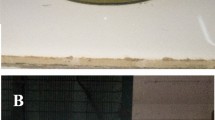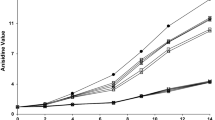Abstract
The aim of this study was to assess the antioxidant power of ethanol extract of garlic (EEGL), isolated or associated with synthetic tert-butylhydroquinone (TBHQ) and butylated hydroxytoluene (BHT) antioxidants on the thermal and oxidative stability of linseed oil. The total phenolic content (Folin–Ciocalteu) of EEGL was preliminary determined as a procedure prior to additive supplementation of linseed oil. The EEGL effect, associated or not with TBHQ or BHT, on the oxidative stability of linseed oil was evaluated using the thermogravimetry, pressurized differential scanning calorimetry (PDSC), PetroOxy, and Rancimat. The results showed that EEGL, isolated or associated to synthetic antioxidants, conferred significant increase to the oxidative stability of linseed oil, offering resistance against primary oxidation, especially for samples LOGL 150, LOGL 100, and LOGL/TBHQ (50/50). Given the antioxidant potential and synergistic effect of garlic extract, when used in isolation or associated with TBHQ or BHT, it is feasible to use EEGL for the partial or total replacement of synthetic antioxidants by the edible oils industry.






Similar content being viewed by others
References
Epaminondas PS, Araújo KLGV, Nascimento JA, Silva MCD, Rosenhaim R, Soledade LEB, et al. Influence of toasting and the seed variety on the physico-chemical and thermo-oxidative characteristics of the flaxseed oil. J Therm Anal Calorim. 2011;106:545–50.
Adkins Y, Kelley DS. Mechanisms underlying the cardioprotective effects of omega-3 polyunsaturated fatty acids. J Nutrit Biochem. 2010;21:781–92.
Rodriguez-Leyva D, Bassett CMC, McCullough R, Pierce GN. The cardiovascular effects of flaxseed and its omega-3 fatty acid, alpha-linolenic acid. Can J Cardiol. 2010;26:489–96.
Naqshbandi A, Rizwan S, Khan F. Dietary supplementation of flaxseed oil ameliorates the effect of cisplatin on rat kidney. J Funct Foods. 2013;5:316–26.
Hsieh C–C, Lin B-F. Dietary factors regulate cytokines in murine models of systemic lupus erythematosus. Autoimmunit Rev. 2011;11:22–7.
Balk EM, Lichtenstein AH, Chung M, Kupelnick B, Chew P, Lau J. Effects of omega-3 fatty acids on serum markers of cardiovascular disease risk: a systematic review. Atherosclerosis. 2006;189:19–30.
Silva AC, Jorge N. Influence of Lentinus edodes and Agaricus blazei extracts on the prevention of oxidation and retention of tocopherols in soybean oil in an accelerated storage test. J Food Sci Technol. 2012. doi: 10.1007/s13197-012-0623-1.
Barriuso B, Astiasarán I, Ansorena D. A review of analytical methods measuring lipid oxidation status in foods: a challenging task. Eur Food Res Technol. 2013;236:1–15.
Ramalho VC, Jorge N. Antioxidantes utilizados em óleos, gorduras e alimentos gordurosos. Quim Nova. 2006;29:755–60.
Silva FAM, Borges MFM, Ferreira MA. Methods for the evaluation of the degree of lipid oxidation and the antioxidant activity. Quim Nova. 1999;22:94–103.
Hras AR, Handolin M, Knez Ž, Bauman D. Comparison of antioxidative and synergistic effects of rosemary extract with a-tocopherol, ascorbyl palmitate and citric acid in sunflower oil. Food Chem. 2000;71:229–33.
Brasil. Ministério da Saúde. Comissão nacional de normas e padrões para alimentos. Resolução n. 04/88. In: Associação Brasileira das Indústrias de Alimentação, editor. São Paulo: ABIA; 2001.
Brewer MS. Natural antioxidants: sources, compounds, mechanisms of action, and potential applications. Comp Rev Food Sci Food Saf. 2011;10:221–47.
Iciek M, Kwiecien I, Wlodek L. Biological properties of garlic and garlic-derived organosulfur compounds. Environ Mol Mutagen. 2009;50:247–65.
Corzo-Martínez M, Corzo N, Villamiel M. Biological properties of onions and garlic. Trends Food Sci Tech. 2007;18:609–25.
Jastrzebski Z, Leontowicz H, Leontowicz M, Namiesnik J, Zachwieja Z, Barton H, et al. The bioactivity of processed garlic (Allium sativum L.) as shown in vitro and in vivo studies on rats. Food Chem Toxicol. 2007;45:1626–33.
Lee J, Gupta S, Huang J-S, Jayathilaka LP, Lee B-S. HPLC-MTT assay: anticancer activity of aqueous garlic extract is from allicin. Anal Biochem. 2013;15(436):187–9.
Cervantes MI, de O Balderas PM, de J Gutiérrez-Baños J, Orozco-Ibarra M, Fernández-Rojas B, Medina-Campos ON, et al. Comparison of antioxidant activity of hydroethanolic fresh and aged garlic extracts and their effects on cerebral ischemia. Food Chem. 2013;140:343–352.
Naznin MT, Maeda T, Morita N. Antioxidant functions of E- and Z-ajoene derived from japanese garlic. Int J Food Prop. 2010;13:821–9.
Silva EYY, Moretti CL, Mattos LM. Compostos funcionais presentes em bulbilhos de alhos armazenados sob refrigeração, provenientes de cultivos no Brasil e na China. Ciência Rural. 2010;40:2580–7.
Slinkard K, Singleton VL. Total phenol analysis: automation and comparison with manual methods. Am J Enol Viticul. 1977;28:49–55.
Epaminondas PS, Araújo KLGV, Souza AL, Silva MCD, Queiroz N, Souza AL, et al. Influence of toasting on the nutritious and thermal properties of flaxseed. J Therm Anal Calorim. 2011;106:551–5.
Wongsa P, Chaiwarit J, Zamaludien A. In vitro screening of phenolic compounds, potential inhibition against α-amylase and α-glucosidase of culinary herbs in Thailand, Food Chem. 2012;131:964–71.
Queiroz YS, Ishimoto EY, Bastos DHM, Sampaio GR, Torres EAFS. Garlic (Allium sativum L.) and ready-to-eat garlic products: in vitro antioxidant activity. Food Chem. 2009;115:371–4.
Michiels JA, Kevers C, Pincemail J, Defraigne JO, Dommes J. Extraction conditions can greatly influence antioxidant capacity assays in plant food matrices. Food Chem. 2012;130:986–93.
Angelo PM, Jorge N. Compostos fenólicos em alimentos: Uma breve revisão. Rev Inst Adolfo Lutz. 2007;66:1–9.
Chung LY. The antioxidant properties of garlic compounds: allyl cysteine, alliin, allicin, and allyl disulfide. J Med Food. 2006;9:205–13.
Nascimento JA, Araújo KLGV, Epaminondas PS, Souza AS, Magnani M, Souza AL, et al. Ethanolic extracts of Moringa oleifera Lam.: evaluation of its potential as an antioxidant additive for fish oil. J Therm Anal Calorim. 2013;13:112.
Santos NA, Cordeiro AMTM, Damasceno SS, Aguiar RT, Rosenhaim R, Carvalho Filho JR, et al. Commercial antioxidants and thermal stability evaluations. Fuel. 2012;97:638–43.
Bonaduce I, Carlyle L, Colombini MP, Duce C, Ferrari C, Ribechini E, Selleri P, Tiné MR. A multi-analytical approach to studying binding media in oil paintings: characterisation of differently pre-treated linseed oil by DE-MS, TG, and GC/MS. J Therm Anal Calorim. 2012;107:1055–66.
Lazzari M, Chiantore O. Drying and oxidative degradation of linseed oil. Polym Degrad Stab. 1999;65:303–13.
Vecchio S, Campanella L, Nuccilli A, Tomassetti M. Kinetic study of thermal breakdown of triglycerides contained in extra-virgin olive oil. J Therm Anal Calorim. 2008;91:51–6.
Araújo KLGV, Epaminondas PS, Silva MCD, Lima AEA, Rosenhaim R, Maia AS, et al. Influence of thermal degradation in the physicochemical properties of fish oil. J Therm Anal and Calorim. 2011;106:557–61.
Araújo SV, Luna FMT, Rola EM Jr, Azevedo DCS, Cavalcante CL Jr. A rapid method for evaluation of the oxidation stability of castor oil FAME: influence of antioxidant type and concentration. Fuel Process Technol. 2009;90:1272–7.
Ramalho EFSM, Albuquerque AR, Souza AL, Barro AK, Maia AS, Santos IMG, et al. Use of different techniques in the evaluation of the oxidative stability of poultry fat biodiesel. J Therm Anal Calorim. 2011;106:787–91.
Bozin B, Mimica-Dukic N, Samojlik I, Goran A, Igic R. Phenolics as antioxidants in garlic (Allium sativum L., Alliaceae). Food Chem. 2008;111:925–9.
Ide N, Lau BH, Ryu K, Matsuura H, Itakura Y. Antioxidant effects of fructosyl arginine, a Maillard reaction product in aged garlic extract. J Nutrit Biochem. 1999;10:372–6.
Kim J-S, Kang O-J, Gweon O-C. Comparison of phenolic acids and flavonoids in black garlic at different thermal processing steps. J Funct Foods. 2013;5:80–6.
Xu G, Ye X, Chen J, Liu D. Effect of heat treatment on the phenolic compounds and antioxidant capacity of citrus peel extract. J Agricul Food Chem. 2007;55:330–5.
Acknowledgements
The authors acknowledge the Brazilian Agencies—National Council for Scientific and Technological Development (CNPq) and Coordination for the Improvement of Higher Education Personnel (CAPES) for the financial support.
Author information
Authors and Affiliations
Corresponding author
Rights and permissions
About this article
Cite this article
Epaminondas, P.S., Araújo, K.L.G.V., Nascimento, J.A. et al. Assessment of the antioxidant effect of ethanol extract of Allium sativum L., isolated and/or synergistically associated with synthetic antioxidants, applied to linseed oil. J Therm Anal Calorim 120, 617–625 (2015). https://doi.org/10.1007/s10973-014-3870-8
Received:
Accepted:
Published:
Issue Date:
DOI: https://doi.org/10.1007/s10973-014-3870-8




